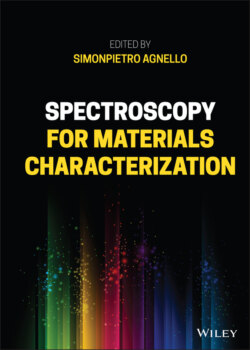Читать книгу Spectroscopy for Materials Characterization - Группа авторов - Страница 67
3.5.1 The Experimental Method
ОглавлениеClassic Raman spectroscopy exploits the Raman effect, discussed in detail in Chapter 5 of this book, that is the inelastic scattering of light associated to the generation or annihilation of vibrational quanta of energy ω V during the interaction of the light beam with the system under study. A typical steady state Raman experiment interrogates the sample by a laser beam at ω, and analyzes the spectral distribution of photons scattered in all directions. In the most common case (Stokes Raman scattering), part of the scattered radiation is found to be red‐shifted to ω′ = ω − ω V, because an energy ω V has been spent to excite phonons of this frequency within the sample. Thus, spectral analysis of the scattered radiation reveals a series of peaks at various ω V reporting on the vibrational mode structure of the system. Vibrational frequencies being much smaller than visible ones, the exciting beam must be narrow enough in frequency to avoid spectral overlap between ω and ω′. Therefore, the vibrational spectral resolution is of the order of the FWHM of the Raman pump beam. Raman spectroscopy is a powerful probe of the vibrational mode structure of any physical system and displays a sensitive dependence on both electronic and molecular structure. Thus, it can be used for accurate chemical recognition and to reveal, with high specificity, any structural changes of the system at study.
On these grounds, femtosecond time‐resolved Raman (TRR) experiments can be conceived as a powerful probe of excited state dynamics of any photoexcited physical system, overcoming the lack of structural sensitivity typical of absorption and fluorescence spectroscopies. In particular, Raman spectra being characteristic of any given state of the system, one should expect strong changes of the vibrational mode pattern whenever the system transitions to an excited state, and subsequently evolves. Following these changes by TRR can be used to extract detailed information on any structural changes or photochemical processes initiated by photoexcitation.
Broadly speaking, TRR spectroscopy is conceptually similar to TA, except, in this case, the observable becomes the change in the Raman spectrum of the sample between a pumped and unpumped situation [52]. TRR is not the only example of femtosecond‐resolved vibrational spectroscopy. An alternative is provided by mid‐infrared TA experiments, which are the time‐resolved counterpart of infrared absorption experiments [56, 57]. Similar to TRR, infrared TA can also probe the vibrational mode structure, but one advantage of TRR spectroscopy is the exclusive use of visible‐ or near‐infrared‐light pulses, which are easier to generate and detect, especially if broadband pulses are needed. Furthermore, due to the higher energy, visible‐light pulses are inherently shorter in time, ultimately providing better time resolution [51]. Another alternative is given by time‐domain techniques founded on TA, such as impulsive stimulated Raman scattering (ISRC) [58], which works best with low‐frequency modes and generally displays lower signal‐to‐noise ratios than state‐of‐the‐art TRR. For these reasons, TRR is generally recognized as the most powerful approach to achieve vibrational spectroscopy with femtosecond resolution, and will be discussed in detail in the rest of this section.
